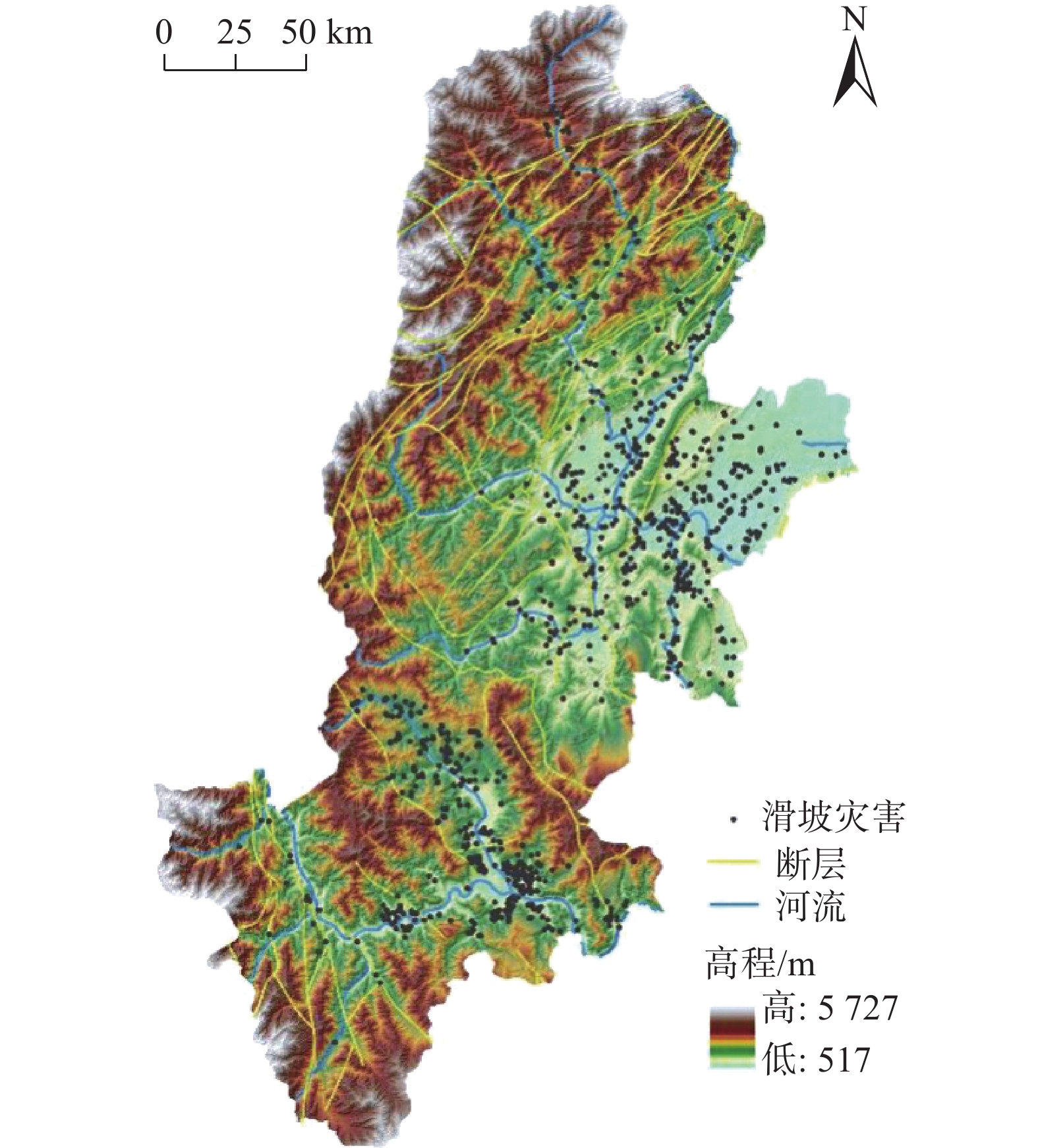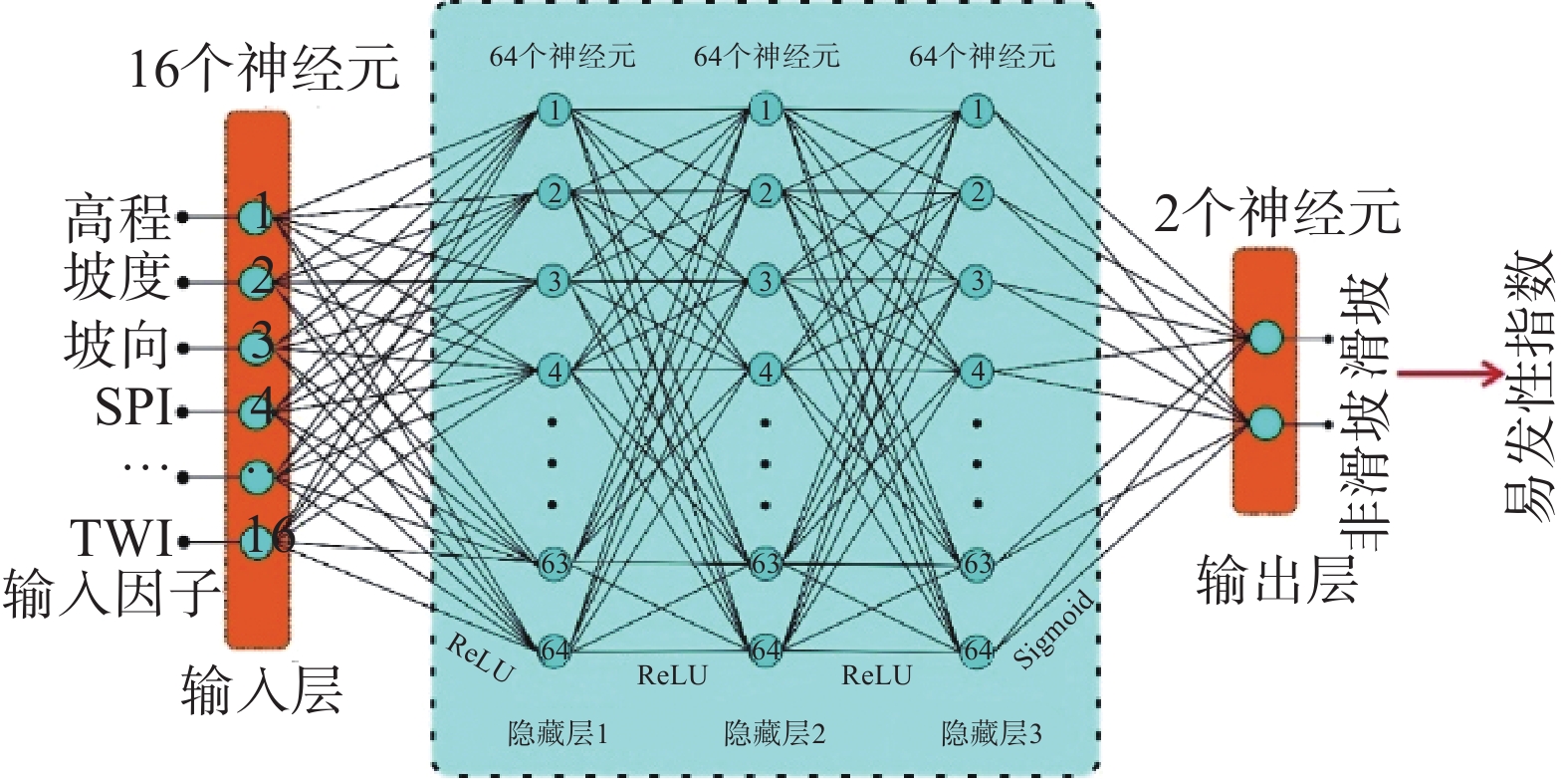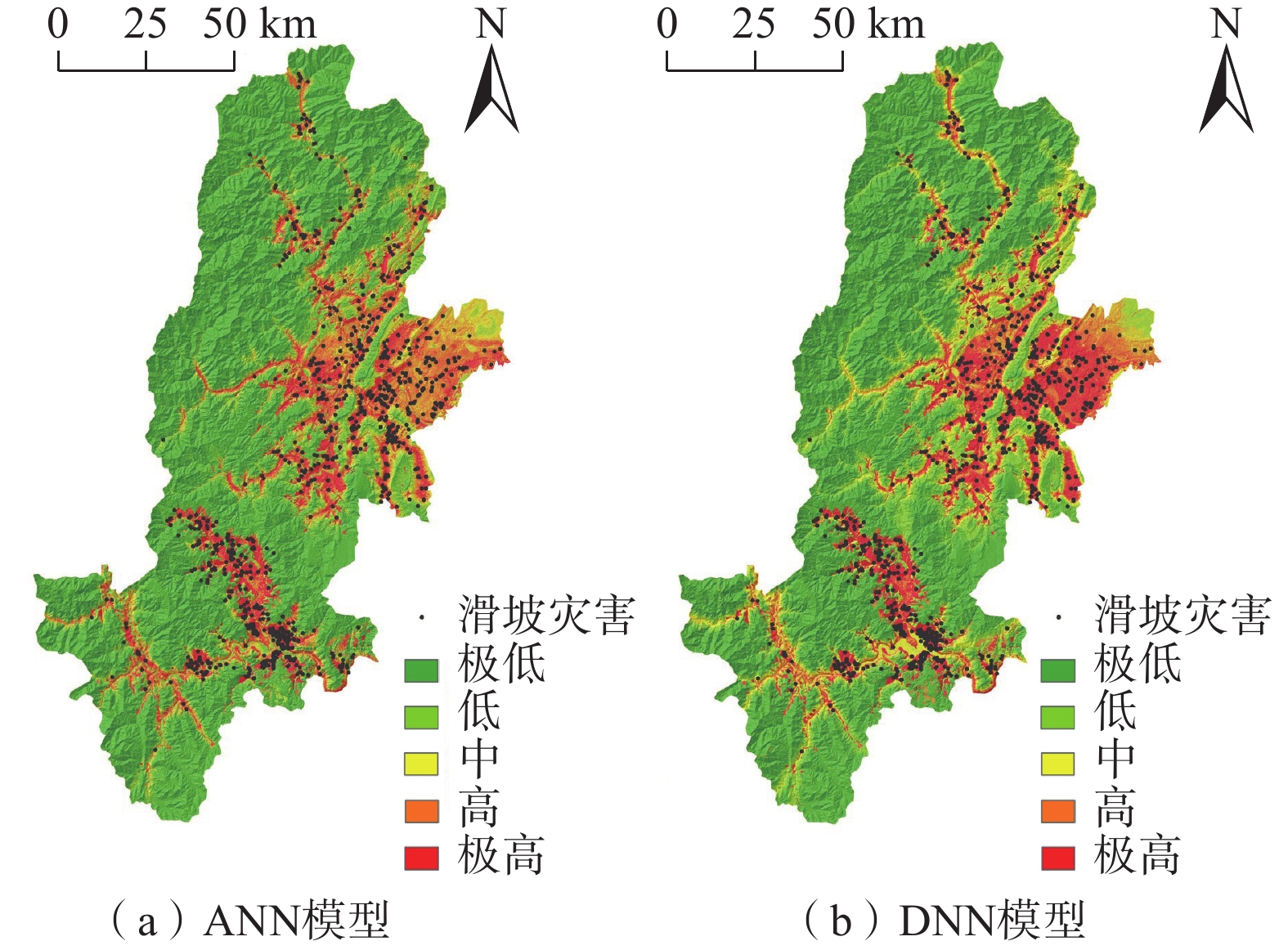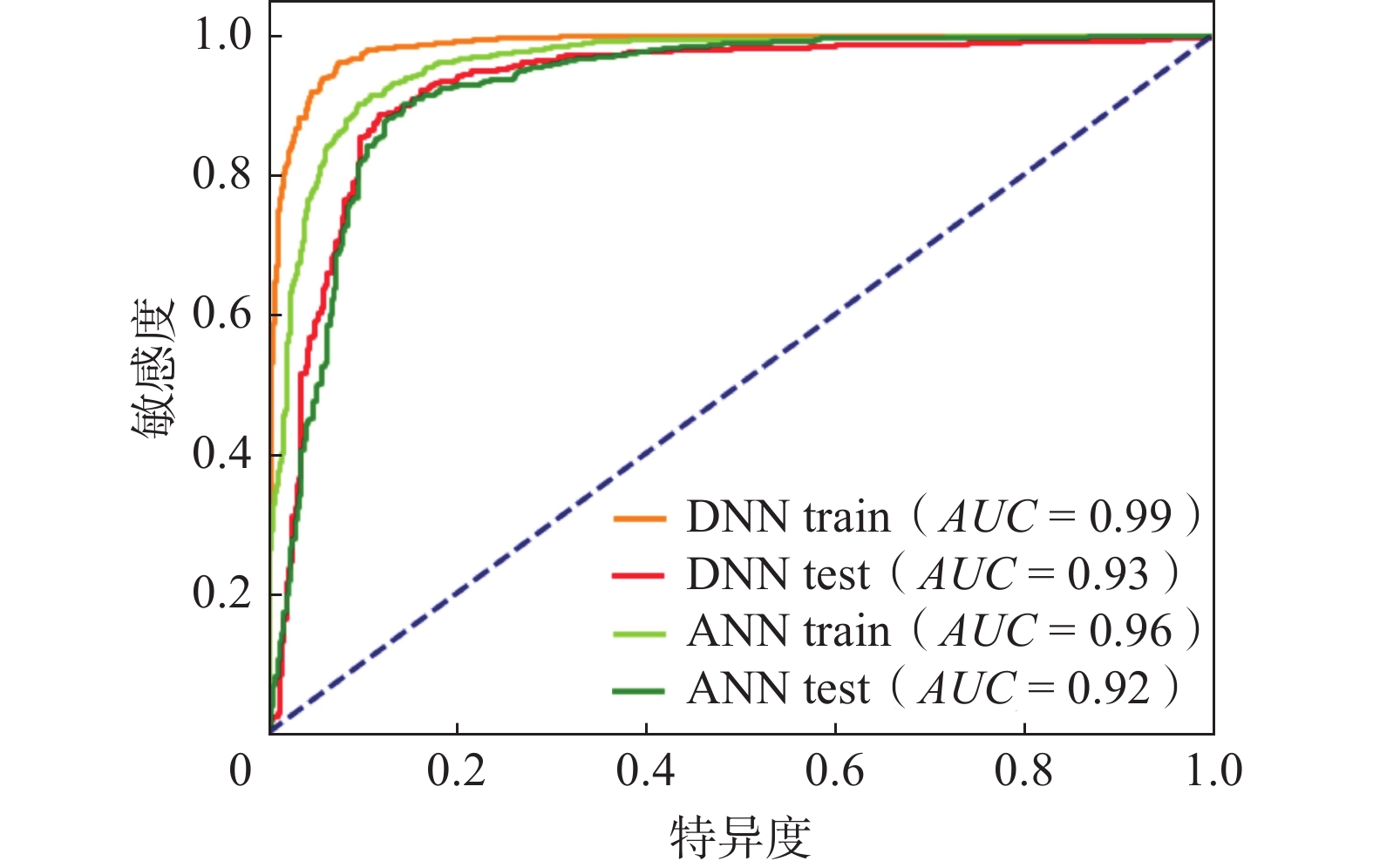Evaluation of landslide susceptibility in Ya’an City based on depth neural network model
-
摘要: 准确的滑坡易发性评价结果是滑坡风险评估的基础,对防灾减灾工作有着重要的意义。文章以雅安市为研究区,在野外地质调查的基础上,选取高程、坡度、坡向、平面曲率、剖面曲率、地形湿度指数、泥沙输运指数、径流强度指数、归一化植被指数、年均降雨量、地震动峰值加速度、地形起伏度、距断层距离、地层岩性、距河流距离、距道路距离等16个因子,构建研究区滑坡易发性评价指标体系,采用度神经网深络(DNN)模型进行滑坡易发性评价,根据易发性指数将研究区划分为极高易发区(12.2%)、高易发区(7.0%)、中易发区(9.8%)、低易发区(17.0%)、极低易发区(54.1%)五个等级,并与人工神经网络(ANN)模型进行对比,用ROC曲线的AUC值进行精度检验。结果表明,DNN模型的评价精度AUC(0.99)大于ANN(0.96)模型。因此,相比ANN模型,DNN模型在该研究区有着更好的拟合能力和预测能力,滑坡极高和高易发区主要分布于雅安市人类工程活动强烈的低海拔地区,沿着道路和水系分布,距道路距离、高程、年均降雨量是影响雅安滑坡发育的主要影响因子。Abstract: Accurate evaluation of landslide susceptibility results are the basis of landslide risk assessment and are of great significance to disaster prevention and reduction. This paper focuses on Ya’an City as the study area and selects various factors, including elevation, slope, aspect, plane curvature, profile curvature, topographic wetness index, sediment transport index, runoff intensity index, normalized difference vegetation index, annual rainfall, peak ground acceleration, topographic relief, distance from fault, stratum lithology, distance from river, and distance from road, to construct a landslide susceptibility evaluation index system. Based on field geological survey data, a deep neural network model is used to evaluate the landslide susceptibility. The study area is classified into five categories based on susceptibility index, including landslide extremely high-prone area (12.2%), landslide high-prone area (7.0%), landslide moderate-prone area (9.8%), landslide low-prone area (17.0%) and landslide extremely low-prone area (54.1%). The accuracy of the DNN model was tested with an AUC value and compared to the artificial neural network (ANN) model. The results show that the DNN model has a higher evaluation accuracy AUC (0.99) compared to ANN (0.96). Thus, the DNN model has a better fitting degree and prediction ability in the study area than the ANN model. The extremely high-prone area and high-prone area of landslides are primarily distributed in the low altitude areas with significant human engineering activities in Ya’an City, along the roads and water systems. The main control factors affecting the development of Ya’an landslide are distance from the road, elevation and annual average rainfall.
-
Keywords:
- landslide /
- susceptibility /
- deep neural network /
- Ya’an City
-
0. 引言
滑坡是一种破坏性极大的自然地质灾害,通常发生于我国的丘陵和山区地带,具有分布范围广、发生频率高、隐蔽性强、破坏性大等特点,特别是重特大型滑坡灾害事件时有发生,往往会造成灾难性的后果,给国家重大工程建设、经济的高质量发展和社会安全造成了严重的威胁[1-2]。西南地区一直以来是我国滑坡灾害的高易发区,位于川藏、川滇公路交会处的雅安市,是四川盆地和青藏高原的过渡地带,区域内地形地貌复杂多变,山脉纵横,新构造活动强烈,复杂的地质背景和脆弱的地质环境致使滑坡灾害极为发育,对当地的城镇化建设和人民的生命财产安全产生巨大的威胁[3]。例如2018年8月6日发生在雅安市汉源县富泉镇的山体滑坡,滑坡堆积体堵塞主沟道形成堰塞坝,并且造成一人死亡,多亩耕地被毁,给人民生命财产安全蒙受重大损失[4]。因此,通过滑坡易发性评价工作能够预测未来滑坡发生的潜在区域,可以为后期滑坡灾害的预警预报、防灾减灾工作提供一定的科学依据。
滑坡易发性评价模型大致可分为5种[5],分别为基于滑坡编录的概率模型[6]、启发式模型[7]、确定性模型[8]、数理统计[9]和机器学习模型[10-11]。近年来,随着地理信息系统和计算机技术的快速发展,机器学习模型在滑坡易发性评价中得到了广泛应用[12-13],常用的机器学习模型包括人工神经网络模型[14-15],支持向量机模型[16-17],决策树模型[18-19],随机森林模型[20-21]等。然而,影响滑坡发生的因素类型较多,易发性评价过程中包含较多数目的评价因子,前面所述的模型为“浅层”机器学习模型,具有一定的局限性,难以更好地挖掘评价因子之间的关系,从而无法得到最理想的结果[22]。随着学者对机器学习进一步深入研究,发现深度学习算法在很大程度上克服了“浅层”机器算法的局限性,通过多层处理,将初始的低层特征向高层特征转化,提取更加高级的特征数据,提高模型的性能[23]。度神经网深络(DNN)模型为最常见的深度学习模型之一,它是由多个隐藏层所组成的神经网络模型,该模型已在其它领域取得了较好的成果[24-25]。因此,基于DNN模型自身优越的特性,将其应用到本文的滑坡易发性评价中,以期获得更可靠的滑坡易发性评价结果。
本文在资料收集、遥感解译、野外调查的基础上,建立了雅安市滑坡灾害空间数据库,综合考虑了研究区地质背景和滑坡灾害的形成机理,选取高程、坡度、坡向、平面曲率,剖面曲率、地形湿度指数(TWI )、泥沙输运指数(STI )、径流强度指数( SPI )、归一化植被指数(NDVI)
、年均降雨量、地震动峰值加速度(PGA ) 、地形起伏度、距断层距离、地层岩性、距河流距离、距道路距离等16个因子作为评价指标,采用DNN模型对雅安市进行滑坡易发性评价,评价结果能够为该区域的防灾减灾工作提供一定的科学依据。 1. 研究区概况
雅安市位于四川盆地西缘、邛崃山东麓,东靠成都、西连甘孜、南界凉山、北接阿坝,总面积约15318 km2。区域气候类型为亚热带季风性湿润气候,年平均气温14 °C左右,因地形原因,区域内降雨较多,主要集中在夏季和秋季,年均降雨为1506 mm。研究区属四川盆地西缘山地,跨四川盆地和青藏高原两大地形区,地势北、西、南三面较高,中、东部低,海拔在517~5727 m,区域内山脉纵横,地表崎岖,地貌类型复杂多样,山地广泛分布,丘陵平坝少。研究区岩性出露较齐全,从前震旦系到第四系均有分布。区域内构造活动强烈,断层褶皱较发育,如龙门山断裂、安宁河断裂、小金河断裂、汉源−甘洛断裂等。近年来随着人类工程活动的加强,以及雅安市脆弱的地质环境和充沛的降雨使滑坡灾害频发,区域共发育滑坡灾害1488处,以小中型滑坡为主,大型滑坡较少,滑坡灾害点分布如图1所示。
本研究数据源:(1)30 m分辨率的数字高程模型(DEM),用于提取高程、坡度、平面曲率、地形起伏度、地形湿度指数等地形、水文数据;(2)全国1∶250万地质图,用于提取岩性、断裂等信息;(3)滑坡灾害数据通过资料收集、遥感解译和野外调查获得;(4)分辨率为30 m的Landsat8影像,用于提取植被覆盖信息(NDVI);(5)全国道路网及水系网,矢量化得到距道路距离、距河流距离等数据。
2. 研究方法
2.1 DNN
DNN是由Hinton等[26]基于人脑学习思路而提出的一种深度学习算法,其结构为输入层、隐藏层和输出层。DNN模型是基于早期的人工神经网络模型改进而成,两种模型的主要区别在于人工神经网络模型为单个隐藏层,DNN模型为多个隐藏层和网络节点数,多个隐藏层可以找到数据的内在特点,从而可以提高神经网络学习多层抽象数据的建模能力[27]。DNN中的多个神经元能够从少量的训练数据中获得数据集共有的本质特性,并且对复杂问题具有很强的建模能力。DNN模型的运行过程如下:(1)网络将输入的正确数据分配给其关联的目标;(2)引入损失函数来计算网络的预测和真实目标;(3)循环训练足够多的次数以生成最小化损失函数的权重。本研究中将隐藏层构建了3层,模型结构为16个输入神经元、2个输出神经元和3个隐藏层的64个神经元,激活函数为ReLU,传递函数为Sigmoid,结构如图2所示。
2.2 ANN
人工神经网络(ANN)属于浅层的机器学习算法,已经广泛运用于各个研究领域[28]。滑坡易发性评价的各因子之间存在复杂的非线性关系,ANN被用于解决这种非线性问题的有效工具之一。ANN体系由输入层、隐含层和输出层三部分构成[29]。网络学习训练过程中,首先根据既定的输入值和输出值分配因子间连接权值,其次,模型通过选取合适的激活函数进行反复训练,以此对连接权值进行重新调整,目的在于正确评估因子间的非线性关系,使得输出的均方误差值更小,模型的精确度相应提高,具体可以表示为:
(1) 式中:
3. 影响因子选取
滑坡的发育是内动力地质条件和外界环境因子共同作用的结果[30]。前人研究表明,滑坡的发生与地形地貌、地质构造、地层岩性、水文条件和人类活动等有着密切的联系[31-32]。本文在前人研究的基础上,依据研究区地质背景和滑坡形成条件选取地形地貌、水文条件、基础地质、植被覆盖度和人类工程活动等5大类共16个滑坡影响因子。影响因子中高程、坡度、TWI、STI、SPI、平面曲率、剖面曲率、NDVI、年均降雨量、地形起伏度等属于连续型数据,采用自然断点法进行分级;坡向、地层岩性、PGA、距断层距离、距道路距离、距河流距离等因子属于离散型数据,采用自然分组进行分级。由工程地质类比法可知,与历史滑坡相似的地质条件更易于潜在滑坡的发育,因此采用频率比法(FR)分析滑坡灾害与影响因子之间的关系,评价影响因子分级状态下对滑坡发生的贡献值。频率比计算表达式如下:
(2) 式中:N——某一分级下的滑坡数量;
N′——研究区滑坡总数;
A——某一分级下的面积/km2;
A′——研究区总面积/km2。
当频率比大于1时,表明该分级状态有利于滑坡灾害的发生;当频率比小于1时,表明该因子分级状态不利于滑坡的发生,其统计结果如表1所示。
表 1 滑坡易发性评价因子分级Table 1. Classification of landslide susceptibility evaluation factors评价因子 因子分级 栅格数 分级面积
占比/%滑坡数/个 滑坡占比/% 频率比 高程/m <1 500 5 204 401 0.31 1 233 0.82 2.69 [1 500,2 500) 6 332 165 0.37 244 0.16 0.44 [2 500,3 500) 3 923 903 0.23 21 0.01 0.06 [3 500,4 500] 1 422 562 0.08 0 0.00 0.00 >4 500 137 525 0.01 0 0.00 0.00 坡度/(°) <10 1 838 336 0.11 298 0.20 1.85 [10,20) 3 394 994 0.20 579 0.39 1.95 [20,30) 4 388 262 0.26 367 0.25 0.96 [30,40) 4 265 068 0.25 181 0.12 0.49 [40,50) 2 411 994 0.14 51 0.03 0.24 [50,60] 642 955 0.04 11 0.01 0.20 >60 78 947 0.00 1 0.00 0.14 坡向 平地 1 347 0.00 0 0.00 0.00 北向 1 967 849 0.12 122 0.08 0.71 东北 2 188 728 0.13 168 0.11 0.88 东向 2 267 964 0.13 226 0.15 1.14 东南 2 482 029 0.15 224 0.15 1.03 南向 1 998 089 0.12 172 0.12 0.98 西南 1 974 369 0.12 206 0.14 1.19 西向 1 942 033 0.11 168 0.11 0.99 西北 2 198 148 0.13 202 0.14 1.05 平面曲率 <-1.5 1 670 196 0.10 67 0.05 0.46 [−1.5,−0.5) 3 515 500 0.21 256 0.17 0.83 [−0.5,0.5) 6 569 423 0.39 828 0.56 1.44 [0.5,1.5] 3 535 554 0.21 258 0.17 0.83 >1.5 1 729 882 0.10 79 0.05 0.52 剖面曲率 <−1.5 2 178 456 0.13 75 0.05 0.39 [−1.5,−0.5) 3 463 053 0.20 271 0.18 0.90 [−0.5,0.5) 6 083 729 0.36 703 0.47 1.32 [0.5,1.5] 3 582 013 0.21 344 0.23 1.10 >1.5 2 207 544 0.13 95 0.06 0.49 TWI <4 2 338 941 0.14 55 0.04 0.27 [4,6) 9 159 642 0.54 775 0.52 0.97 [6,8) 3 579 077 0.21 378 0.25 1.21 [8,10) 1 206 481 0.07 170 0.11 1.61 [10,12] 435 025 0.03 66 0.04 1.74 >12 301 390 0.02 44 0.03 1.67 SPI <30 6 586 113 0.39 647 0.43 1.12 [30,70) 3 369 824 0.20 273 0.18 0.93 [70,110) 1 583 666 0.09 127 0.09 0.92 [110,150] 938 662 0.06 70 0.05 0.85 >150 4 542 291 0.27 371 0.25 0.93 STI <10 4 335 955 0.25 567 0.38 1.50 [10,20) 4 286 230 0.25 340 0.23 0.91 [20,30) 2 423 036 0.14 185 0.12 0.87 [30,40) 1 498 141 0.09 103 0.07 0.79 [40,50] 965 895 0.06 56 0.04 0.66 >50 3 511 299 0.21 237 0.16 0.77 NDVI <0 572 046 0.03 12 0.01 0.24 [0,0.1) 4 391 796 0.26 243 0.16 0.63 [0.1,0.2) 7 452 084 0.44 755 0.51 1.16 [0.2,0.3] 4 210 818 0.25 445 0.30 1.21 >0.3 393 811 0.02 33 0.02 0.96 降雨/mm <1 100 347 828 0.02 51 0.03 1.68 [1 100,1 200) 5 875 063 0.35 1 123 0.75 2.19 [1 200,1 300) 6 988 356 0.41 306 0.21 0.50 [1 300,1 400] 3 161 041 0.19 8 0.01 0.03 >1 400 648 268 0.04 0 0.00 0.00 PGA 0.10 5 547 189 0.33 642 0.43 1.32 0.15 6 626 792 0.39 687 0.46 1.19 0.20 4 846 575 0.28 159 0.11 0.38 地形起伏度/m <200 3 046 522 0.18 718 0.48 2.70 [200,400) 8 659 562 0.51 660 0.44 0.87 [400,600) 4 893 981 0.29 106 0.07 0.25 [600,800] 400 489 0.02 4 0.01 0.11 >800 20 002 0.00 0 0.00 0.00 岩性 A 6 690 039 0.39 469 0.32 0.80 B 1 930 133 0.11 412 0.28 2.44 C 2 589 329 0.15 86 0.06 0.38 D 2 805 880 0.16 86 0.06 0.35 E 1 280 290 0.08 54 0.04 0.48 F 607 260 0.04 142 0.10 2.67 G 1 117 652 0.07 239 0.16 2.45 距河流距离/m <200 359 325 0.02 96 0.06 3.06 [200,400) 356 325 0.02 75 0.05 2.41 [400,600) 353 757 0.02 80 0.05 2.59 [600,800) 350 074 0.02 81 0.05 2.65 [800,1 000] 348 031 0.02 70 0.05 2.30 >1 000 15 253 044 0.90 1 086 0.73 0.81 距断层距离/m <1 000 3 769 155 0.22 239 0.16 0.73 [1 000,2 000) 2 849 793 0.17 166 0.11 0.67 [2 000,3 000) 2 175 357 0.13 143 0.10 0.75 [3 000,4 000) 1 662 881 0.10 116 0.08 0.80 [4 000,5 000] 1 315 010 0.08 156 0.10 1.36 >5 000 5 248 360 0.31 668 0.45 1.46 距道路距离/m <500 1 770 408 0.10 606 0.41 3.92 [500,1 000) 1 391 697 0.08 233 0.16 1.92 [1 000,1 500) 1 222 996 0.07 222 0.15 2.08 [1 500,2 000) 1 081 568 0.06 127 0.09 1.34 [2 000,2 500] 968 316 0.06 69 0.05 0.82 >2 500 10 585 571 0.62 231 0.16 0.25 注:A为较坚硬的砂岩页岩板岩;B为较软的泥岩千枚岩页岩;C为软硬相间的碳酸盐岩及碎屑岩;D为较坚硬的石灰岩白云岩;E为坚硬的玄武岩苦橄岩角质岩;F为松散的堆积物冲积物;G为较坚硬的长石石英砂岩。 3.1 地形地貌对滑坡的影响
地形地貌因子主要包括:高程、坡度、坡向、平面曲率、剖面曲率、地形起伏度。高程对坡体的势能、应力分布和温度气候等产生很大影响[33]。统计结果表明(图3和表1),研究区高程在517~5 727 m,滑坡主要分布于高程小于1 500 m范围内,占研究区总滑坡面积的31%,其频率比达到2.69,表明该高程范围更有利于滑坡的发生。坡度表示斜坡体陡缓的程度,可以为滑坡提供有效临空面,并影响斜坡体的重力分布。统计结果表明(图3和表1),坡度在10°~20°范围内频率比达到1.95,说明该范围发生滑坡的可能性更大。坡向对斜坡的影响主要在于决定其光照时长,冻融程度以及植被发育,从而影响斜坡岩土体的理化特性。统计结果表明(图3和表1),坡向朝西南的频率比大于1,表明此坡向滑坡发育的可能性更大。平面曲率反应地表的形态[19],曲率小于0时地形呈凹型,反之大于0时呈凸型,相对而言凸型坡比凹型坡更有利于滑坡灾害的发生。统计结果表明(图3和表1),平面曲率在-0.5~0.5范围内频率达到1.44,更利于滑坡的发生。剖面曲率是指沿最大坡降方向高程的变化率,反应斜坡的急缓程度。统计结果表明(图3和表1),剖面曲率在-0.5~1.5范围内频率比皆大于1,且-0.5~0.5范围内频率比最大为1.32,说明该范围对滑坡有着促进作用。地形起伏度是指在一个特定的区域内,最高点海拔高度与最低点海拔高度的差值,是描述地貌形态的定量指标。统计结果表明(图3和表1),地形起伏度小于200 m时,对应最大频率比为2.70,表明该范围有利于滑坡的发育。
3.2 基础地质对滑坡的影响
基础地质因子包括:地层岩性、距断层距离、PGA。地层岩性是滑坡产生的物质基础,决定着岩体的强度,研究表明不同岩性区域发生的滑坡具有显著差异[34]。根据研究区岩性的坚硬程度将其分为:较坚硬的砂岩页岩板岩(A)、较软的泥岩千枚岩页岩(B)、软硬相间的碳酸盐岩及碎屑岩(C)、较坚硬的石灰岩白云岩(D)、坚硬的玄武岩苦橄岩角质岩(E)、松散的堆积物冲积物(F)、较坚硬的长石石英砂岩(G)等7类,其中B、F、G类的频率比均大于2,说明该三类岩土体对滑坡发生有正向促进作用。断层是影响滑坡发生的一个重要因素。断层褶皱发育通常导致该区域内岩体结构破碎,节理裂隙发育。统计结果表明(图3和表1),滑坡主要发生于距断层距离4000 m以上,频率值分别达1.36、1.46,表明该距离范围发生滑坡的可能性更大。地震是造成滑坡的重要诱发因素,地震时产生的地面加速度往往与滑坡数量及破坏程度呈正相关,地震因素通常考虑PGA对滑坡的影响[35]。统计结果表明(图3和表1),PGA为0.1或0.15时,对应频率比分别为1.32、1.39,表明对滑坡的发生起正向作用。
3.3 水文环境对滑坡的影响
水文环境影响因子有TWI、SPI、STI、年均降雨量及距水系距离。大多数自然灾害的发生都离不开水的作用,一方面,河流水系对地下水的补给使得坡面岩土体中水位上升,对岩土体有润滑作用,导致岩土体强度劣化,进而大大降低其稳定性;除此之外,河流的浸润冲刷使得两岸出现不同程度的临空面,为滑坡的发生创造了条件;另一方面,强降雨等对坡体表面不断侵蚀,形成一系列裸露的洞穴及冲蚀沟,为滑坡的进一步扩展提供了基础。TWI反应地表持水能力,用于评估区域内某一点的湿度。统计结果表明(图3和表1),TWI大于6时,频率比均大于1,且10~12范围内频率比最大为1.74,说明岩土含水率越高对滑坡越有利。SPI是衡量地表某一点的势流侵蚀能力,作为分析区域稳定性的一个重要指标,径流侵蚀强度越大,更容易造成斜坡失稳破坏。统计结果表明(图3和表1),SPI小于30时,对应频率比为1.12,说明该范围的水流功率有助于滑坡的发生。STI是测量地表径流侵蚀强度的一个重要指标。泥沙输运指数越大,堆积的沉积物越厚,容易发生滑坡灾害。统计结果表明(图3和表1),泥沙输运指数小于10时频率比为1.5,对滑坡灾害的发育有促进作用。降雨形成的地表水冲刷岩土表面产生崩解软化现象,部分渗入土体内部改变黏聚力,从而降低了岩土体的强度,影响斜坡的稳定性。统计结果表明(图3和表1),降雨在1100~1200 mm时频率比为2.19,表明对滑坡的促进作用较大。河流的侵蚀和切割会形成一系列临空面,除此之外,长期对坡脚的浸泡和浸润降低了岩土体的强度,使得斜坡稳定性大大降低。统计结果表明(图3和表1),距河流距离1000 m以内频率比均大于2,且距离小于500 m时频率比最大为3.06,表明距河流越近对滑坡的促进作用越大。
3.4 植被覆盖度对滑坡影响
某一区域的植被覆盖度会影响滑坡的分布,主要表现为植被覆盖度低的地区岩土体的抗风化能力弱,强度低。NDVI反映某一区域的植被覆盖程度,NDVI的正值表示植被覆盖率高,负值表示植被覆盖率低。统计结果表明(图3和表1),研究区整体植被覆盖率较低,但NDVI在0.1~0.2、0.2~0.3区间时,对应频率比为1.16、1.21,表明更有利于滑坡的发生。
3.5 人类工程活动对滑坡的影响
人类工程活动主要是距道路距离,道路建设过程中,不可避免地对临近边坡进行开挖,破坏现场植被,打破边坡内部的应力平衡状态,从而引发滑坡灾害。统计结果表明(图3和表1),距道路距离500 m以内频率比高达3.92,说明距道路越近对滑坡的促进作用越大。
4. 雅安市滑坡易发性评价
4.1 评价因子独立性检验
用于滑坡易发性评价的各因子之间,相关性过高会导致评价精度大大降低。因此,为确保参与评价的各因子之间保持相对独立性需进行因子之间独立性检验。本文通过SPSS18.0软件计算得各因子之间皮尔森相关系数(表2),当相关系数绝对值大于0.7时,表明两因子之间存在较高的相关性[36]。统计结果表明,各因子之间相关系数绝对值均小于0.7,16个影响因子间相关性较小,将所有因子用于研究区滑坡易发性建模。
表 2 影响因子的相关性分析Table 2. Correlation analysis of impact factors因子 高程 坡度 坡向 平面曲率 剖面曲率 TWI STI SPI NDVI 降雨 PGA 起伏度 断层 岩性 河流 道路 高程 1.00 坡度 0.41 1.00 坡向 −0.03 −0.01 1.00 平面曲率 0.01 0.00 0.01 1.00 剖面曲率 0.01 0.05 0.03 0.18 1.00 TWI −0.19 −0.39 0.02 −0.28 0.17 1.00 STI 0.17 0.45 0.02 −0.35 0.17 0.51 1.00 SPI 0.08 0.25 0.03 −0.39 0.18 0.64 0.92 1.00 NDVI −0.23 −0.10 −0.68 −0.01 0.07 0.04 −0.04 −0.01 1.00 降雨 0.67 0.28 −0.04 0.01 0.02 −0.16 0.10 0.03 −0.23 1.00 PGA 0.28 0.21 −0.01 −0.02 0.09 −0.05 0.15 0.10 0.01 0.31 1.00 起伏度 0.31 0.18 0.01 0.01 0.08 −0.06 0.05 0.16 −0.36 0.23 0.12 1.00 断层 −0.14 −0.20 0.02 0.00 −0.03 0.05 −0.13 −0.09 −0.07 0.00 −0.15 0.01 1.00 岩性 −0.08 −0.08 −0.01 0.01 0.03 0.03 −0.06 −0.03 0.02 −0.01 0.10 −0.04 −0.01 1.00 河流 0.24 0.06 0.03 −0.02 −0.01 −0.16 −0.04 −0.09 0.04 0.29 0.08 −0.06 −0.07 −0.07 1.00 道路 0.61 0.30 −0.02 −0.03 −0.01 −0.17 0.12 0.03 −0.06 0.56 0.27 0.10 −0.16 −0.08 0.39 1.00 4.2 滑坡易发性建模
采用DNN模型和ANN模型进行滑坡易发性评价时,需要选取与滑坡相同数量的非滑坡样本,为了降低非滑坡样本选择的错误率,选取时将滑坡区域缓冲1 km,在缓冲区域外随机选择1 488处非滑坡点。将滑坡和非滑坡样本数据按照7∶3的比例随机分成两组,70%的数据用于模型的训练,剩余30%数据用于模型的检验。
本文基于Python编程语言进行DNN和ANN模型的构建和滑坡易发性的预测。将选取的样本数据集输入构建的DNN和ANN模型中进行训练,选取均方误差作为损失函数来测度模型的输出值和真实因变量值之间的差异,使用RMSProp作为优化器。将16个影响因子输入训练好的模型进行滑坡易发性的预测,得到研究区滑坡易发性指数(0~1),采用自然间断法将其划分为5个易发性等级,依次为极高易发区、高易发区、中易发区、低易发区、极低易发区,其结果如图4所示。ANN模型的易发性等级从高到低的面积百分比为12.3%、10.0%、7.4%、8.2%、62.1%,DNN模型的为12.2%、7.0%、9.8%、17.0%、54.1%。从图4易发性分区可知,滑坡极高和高易发区主要分布在雅安市低海拔地区,沿着道路和水系呈带状分布,低易发区分布在人类工程活动较少的高海拔地区,与历史滑坡的分布规律较符合。
4.3 评价精度对比分析
ROC曲线为受试者工作特征曲线(receiveroperating characteristic curve,ROC),是反映敏感性和特异性连续变量的综合指标,由于考虑了所有滑坡点的计算结果,被广泛运用于滑坡易发性精确度检验中[37]。本文采用ROC曲线下面积(area under curve,AUC)对DNN模型和ANN模型的训练成功率和预测准确性进行验证。其中训练数据集的AUC表示模型的拟合能力,而测试数据集的AUC表示模型的预测能力。根据Hosmer和Lemeshow提出的评判标准:0.9<AUC<1.0时,表明预测准确度极好,模型性能出色[38]。如图5所示,DNN模型和ANN模型的训练集AUC值分别为0.99和0.96,测试集的AUC值分别为0.93和0.92。结果表明两个模型都有着较高的拟合能力和预测能力,但DNN训练集和测试集的AUC值均高于ANN模型,说明DNN模型在该研究区有着更好的拟合能力和预测能力相比ANN模型。
根据预测生成的滑坡易发性区划图和历史滑坡,采用频率比定量分析两个模型的易发性分区。当频率比大于1时,该区域易发生滑坡,且频率比越大,滑坡发生的可能性也越大。通过统计历史滑坡在各个易发性等级的分布状况,计算其频率比(表3)。从历史滑坡分布来看,ANN模型的极高易发区(12.25%)中历史滑坡1022处,占总滑坡68.68%,DNN模型的极高易发区(12.16%)中历史滑坡1213处,占总滑坡81.52%;ANN模型极低易发区(62.13%)中历史滑坡28处,占总滑坡的1.88%,DNN模型的极低易发区(54.12%)中历史滑坡12处,占总滑坡的0.81%。从频率比的统计分析可知,DNN模型的极高易发区(6.7039)大于ANN模型的极高易发区(5.6068)的频率比值,且低易发区DNN模型(0.0149)的频率比值小于ANN模型(0.0303)。各个统计指标表明,两个模型生成的易发性分区图,DNN模型的易发性评价结果与历史滑坡的分布比ANN模型更为合理。
表 3 滑坡易发性评价频率比Table 3. Frequency ratio of landslide susceptibility assessment模型 易发性等级 分级栅格数 分级比例 滑坡数量 滑坡比例 频率比 ANN 极低 10 574 871 0.62 28 0.02 0.03 低 1 397 388 0.21 33 0.02 0.27 中 1 264 627 0.43 64 0.04 0.58 高 1 698 651 0.01 341 0.23 2.30 极高 2 085 018 0.12 1 022 0.69 5.61 DNN 极低 9 211 525 0.54 12 0.01 0.01 低 2 876 474 0.17 17 0.01 0.07 中 1 673 121 0.10 76 0.05 0.52 高 1 189 737 0.07 170 0.11 1.63 极高 2 069 700 0.12 1 213 0.82 6.70 4.4 影响因子的权重分析
滑坡的发生是多种因素共同作用的结果,各个因子影响滑坡发生的方式不同。因此,有必要研究各个影响因子的重要性和作用机制,可以为滑坡灾害的预测和防治提供指导。本研究采用信息增益的方法进行因子重要性分析,信息增益(IG)的特征选择方法被用来选择一个最优评价指标体系,以提高滑坡易发性评价结果的准确度。信息增益法是通过计算输入因子对应的输出类别y的熵来确定的,可表示为:
(3) 式中:
其计算公式如下:
(4) (5) 该方法得出AM值揭示了影响因子与滑坡发生之间的重要性。权重值越大,相应因子对滑坡发生的贡献越大。计算结果如图6所示,影响研究区滑坡的主要影响因子为距道路距离(0.267)、高程(0.192)和年降雨量(0.128)。在低海拔区域,道路沿线人类工程活动较为频繁,大量房屋和道路的修建、边坡开挖等打破斜坡原有的自然平衡态,增加滑坡灾害对自然因素变化的敏感度,成为滑坡发生的直接诱因。除此之外,雅安市气候类型为亚热带季风性湿润气候,由于地处四川盆地西隅,背靠青藏高原冷高压,面向东南季风暖湿气流,因此,夏季多地形雨和锋面雨,秋季多绵雨。降水多,云量多,日照少,与国内基本上同纬度的亚热带季风区城市相比较,是距海最远,温差最小,降水量最多的城市,素有“雨城”之称。因研究区春秋两季的降雨充沛,大面积侵蚀斜坡表面岩土体,雨水通过孔隙、裂隙等通道入渗至斜坡内部,引起地下水位大幅上升,导致斜坡体的孔隙压力增大,强度劣化等,容易引发滑坡灾害。因此,影响滑坡发育的因子统计分析结果与实际情况基本一致。
5. 结论
本文在滑坡灾害的遥感影像解译和野外地质灾害调查的基础上,以雅安市作为研究区,选取高程等16个影响因子建立了滑坡易发性评价体系。基于GIS和Python语言,运用DNN模型和ANN模型对研究区进行滑坡易发性评价,得出以下结论:
(1)利用自然间断点法将两种模型进行易发性等级划分。DNN模型易发区划分为极高易发区(12.2%)、高易发区(7.0%)、中易发区(9.8%)、低易发区(17.0%)、极低易发区(54.1%);ANN模型易发区划分为极高易发区(12.3%)、高易发区(10.0%)、中易发区(7.4%)、低易发区(8.2%)、极低易发区(62.0%)。两个模型的高和极高易发区主要分布在人类工程活动较多的低海拔地区,滑坡易发性分区与历史滑坡的分布存在较好的一致性。
(2)采用频率比和ROC曲线对评价结果进行精度检验,并进行DNN模型和ANN 模型的对比分析。DNN模型的极高易发区(6.7039)大于ANN模型的极高易发区(5.6068)的频率比值,且DNN模型和ANN模型的训练集AUC值分别为0.99和0.96,测试集的AUC值分别为0.93和0.92,DNN的训练集和测试集的AUC值均高于ANN模型,相比ANN模型,DNN模型在雅安市的滑坡易发性评价中有较优的预测能力,能够较好地反映研究区滑坡易发性分布状况,为未来的防灾减灾提供一定的理论参考。
(3)采用信息增益法进行因子重要性分析,结果表明影响研究区滑坡的主要影响因子为距道路距离(0.267)、高程(0.192)及年均降雨量(0.128)。因子权重分析结果与当地实际情况基本一致。
-
表 1 滑坡易发性评价因子分级
Table 1 Classification of landslide susceptibility evaluation factors
评价因子 因子分级 栅格数 分级面积
占比/%滑坡数/个 滑坡占比/% 频率比 高程/m <1 500 5 204 401 0.31 1 233 0.82 2.69 [1 500,2 500) 6 332 165 0.37 244 0.16 0.44 [2 500,3 500) 3 923 903 0.23 21 0.01 0.06 [3 500,4 500] 1 422 562 0.08 0 0.00 0.00 >4 500 137 525 0.01 0 0.00 0.00 坡度/(°) <10 1 838 336 0.11 298 0.20 1.85 [10,20) 3 394 994 0.20 579 0.39 1.95 [20,30) 4 388 262 0.26 367 0.25 0.96 [30,40) 4 265 068 0.25 181 0.12 0.49 [40,50) 2 411 994 0.14 51 0.03 0.24 [50,60] 642 955 0.04 11 0.01 0.20 >60 78 947 0.00 1 0.00 0.14 坡向 平地 1 347 0.00 0 0.00 0.00 北向 1 967 849 0.12 122 0.08 0.71 东北 2 188 728 0.13 168 0.11 0.88 东向 2 267 964 0.13 226 0.15 1.14 东南 2 482 029 0.15 224 0.15 1.03 南向 1 998 089 0.12 172 0.12 0.98 西南 1 974 369 0.12 206 0.14 1.19 西向 1 942 033 0.11 168 0.11 0.99 西北 2 198 148 0.13 202 0.14 1.05 平面曲率 <-1.5 1 670 196 0.10 67 0.05 0.46 [−1.5,−0.5) 3 515 500 0.21 256 0.17 0.83 [−0.5,0.5) 6 569 423 0.39 828 0.56 1.44 [0.5,1.5] 3 535 554 0.21 258 0.17 0.83 >1.5 1 729 882 0.10 79 0.05 0.52 剖面曲率 <−1.5 2 178 456 0.13 75 0.05 0.39 [−1.5,−0.5) 3 463 053 0.20 271 0.18 0.90 [−0.5,0.5) 6 083 729 0.36 703 0.47 1.32 [0.5,1.5] 3 582 013 0.21 344 0.23 1.10 >1.5 2 207 544 0.13 95 0.06 0.49 TWI <4 2 338 941 0.14 55 0.04 0.27 [4,6) 9 159 642 0.54 775 0.52 0.97 [6,8) 3 579 077 0.21 378 0.25 1.21 [8,10) 1 206 481 0.07 170 0.11 1.61 [10,12] 435 025 0.03 66 0.04 1.74 >12 301 390 0.02 44 0.03 1.67 SPI <30 6 586 113 0.39 647 0.43 1.12 [30,70) 3 369 824 0.20 273 0.18 0.93 [70,110) 1 583 666 0.09 127 0.09 0.92 [110,150] 938 662 0.06 70 0.05 0.85 >150 4 542 291 0.27 371 0.25 0.93 STI <10 4 335 955 0.25 567 0.38 1.50 [10,20) 4 286 230 0.25 340 0.23 0.91 [20,30) 2 423 036 0.14 185 0.12 0.87 [30,40) 1 498 141 0.09 103 0.07 0.79 [40,50] 965 895 0.06 56 0.04 0.66 >50 3 511 299 0.21 237 0.16 0.77 NDVI <0 572 046 0.03 12 0.01 0.24 [0,0.1) 4 391 796 0.26 243 0.16 0.63 [0.1,0.2) 7 452 084 0.44 755 0.51 1.16 [0.2,0.3] 4 210 818 0.25 445 0.30 1.21 >0.3 393 811 0.02 33 0.02 0.96 降雨/mm <1 100 347 828 0.02 51 0.03 1.68 [1 100,1 200) 5 875 063 0.35 1 123 0.75 2.19 [1 200,1 300) 6 988 356 0.41 306 0.21 0.50 [1 300,1 400] 3 161 041 0.19 8 0.01 0.03 >1 400 648 268 0.04 0 0.00 0.00 PGA 0.10 5 547 189 0.33 642 0.43 1.32 0.15 6 626 792 0.39 687 0.46 1.19 0.20 4 846 575 0.28 159 0.11 0.38 地形起伏度/m <200 3 046 522 0.18 718 0.48 2.70 [200,400) 8 659 562 0.51 660 0.44 0.87 [400,600) 4 893 981 0.29 106 0.07 0.25 [600,800] 400 489 0.02 4 0.01 0.11 >800 20 002 0.00 0 0.00 0.00 岩性 A 6 690 039 0.39 469 0.32 0.80 B 1 930 133 0.11 412 0.28 2.44 C 2 589 329 0.15 86 0.06 0.38 D 2 805 880 0.16 86 0.06 0.35 E 1 280 290 0.08 54 0.04 0.48 F 607 260 0.04 142 0.10 2.67 G 1 117 652 0.07 239 0.16 2.45 距河流距离/m <200 359 325 0.02 96 0.06 3.06 [200,400) 356 325 0.02 75 0.05 2.41 [400,600) 353 757 0.02 80 0.05 2.59 [600,800) 350 074 0.02 81 0.05 2.65 [800,1 000] 348 031 0.02 70 0.05 2.30 >1 000 15 253 044 0.90 1 086 0.73 0.81 距断层距离/m <1 000 3 769 155 0.22 239 0.16 0.73 [1 000,2 000) 2 849 793 0.17 166 0.11 0.67 [2 000,3 000) 2 175 357 0.13 143 0.10 0.75 [3 000,4 000) 1 662 881 0.10 116 0.08 0.80 [4 000,5 000] 1 315 010 0.08 156 0.10 1.36 >5 000 5 248 360 0.31 668 0.45 1.46 距道路距离/m <500 1 770 408 0.10 606 0.41 3.92 [500,1 000) 1 391 697 0.08 233 0.16 1.92 [1 000,1 500) 1 222 996 0.07 222 0.15 2.08 [1 500,2 000) 1 081 568 0.06 127 0.09 1.34 [2 000,2 500] 968 316 0.06 69 0.05 0.82 >2 500 10 585 571 0.62 231 0.16 0.25 注:A为较坚硬的砂岩页岩板岩;B为较软的泥岩千枚岩页岩;C为软硬相间的碳酸盐岩及碎屑岩;D为较坚硬的石灰岩白云岩;E为坚硬的玄武岩苦橄岩角质岩;F为松散的堆积物冲积物;G为较坚硬的长石石英砂岩。 表 2 影响因子的相关性分析
Table 2 Correlation analysis of impact factors
因子 高程 坡度 坡向 平面曲率 剖面曲率 TWI STI SPI NDVI 降雨 PGA 起伏度 断层 岩性 河流 道路 高程 1.00 坡度 0.41 1.00 坡向 −0.03 −0.01 1.00 平面曲率 0.01 0.00 0.01 1.00 剖面曲率 0.01 0.05 0.03 0.18 1.00 TWI −0.19 −0.39 0.02 −0.28 0.17 1.00 STI 0.17 0.45 0.02 −0.35 0.17 0.51 1.00 SPI 0.08 0.25 0.03 −0.39 0.18 0.64 0.92 1.00 NDVI −0.23 −0.10 −0.68 −0.01 0.07 0.04 −0.04 −0.01 1.00 降雨 0.67 0.28 −0.04 0.01 0.02 −0.16 0.10 0.03 −0.23 1.00 PGA 0.28 0.21 −0.01 −0.02 0.09 −0.05 0.15 0.10 0.01 0.31 1.00 起伏度 0.31 0.18 0.01 0.01 0.08 −0.06 0.05 0.16 −0.36 0.23 0.12 1.00 断层 −0.14 −0.20 0.02 0.00 −0.03 0.05 −0.13 −0.09 −0.07 0.00 −0.15 0.01 1.00 岩性 −0.08 −0.08 −0.01 0.01 0.03 0.03 −0.06 −0.03 0.02 −0.01 0.10 −0.04 −0.01 1.00 河流 0.24 0.06 0.03 −0.02 −0.01 −0.16 −0.04 −0.09 0.04 0.29 0.08 −0.06 −0.07 −0.07 1.00 道路 0.61 0.30 −0.02 −0.03 −0.01 −0.17 0.12 0.03 −0.06 0.56 0.27 0.10 −0.16 −0.08 0.39 1.00 表 3 滑坡易发性评价频率比
Table 3 Frequency ratio of landslide susceptibility assessment
模型 易发性等级 分级栅格数 分级比例 滑坡数量 滑坡比例 频率比 ANN 极低 10 574 871 0.62 28 0.02 0.03 低 1 397 388 0.21 33 0.02 0.27 中 1 264 627 0.43 64 0.04 0.58 高 1 698 651 0.01 341 0.23 2.30 极高 2 085 018 0.12 1 022 0.69 5.61 DNN 极低 9 211 525 0.54 12 0.01 0.01 低 2 876 474 0.17 17 0.01 0.07 中 1 673 121 0.10 76 0.05 0.52 高 1 189 737 0.07 170 0.11 1.63 极高 2 069 700 0.12 1 213 0.82 6.70 -
[1] 彭建兵,崔鹏,庄建琦. 川藏铁路对工程地质提出的挑战[J]. 岩石力学与工程学报,2020,39(12):2377 − 2389. [PENG Jianbing,CUI Peng,ZHUANG Jianqi. Challenges to engineering geology of Sichuan—Tibet railway[J]. Chinese Journal of Rock Mechanics and Engineering,2020,39(12):2377 − 2389. (in Chinese with English abstract) DOI: 10.13722/j.cnki.jrme.2020.0446 Peng Jianbing, Cui Peng, Zhuang Jianqi. Challenges to engineering geology of Sichuan—Tibet railway[J]. Chinese Journal of Rock Mechanics and Engineering, 2020, 39(12): 2377-2389. (in Chinese with English abstract) DOI: 10.13722/j.cnki.jrme.2020.0446
[2] ZHUANG Jianqi, PENG Jianbing , WANG Gonghui, et al. Distribution and characteristics of landslide in loess plateau:A case study in Shaanxi Province[J]. Engineering Geology,2018,236:89 − 96. DOI: 10.1016/j.enggeo.2017.03.001
[3] GUO Changbao, WU Ruian, JIANG Liangwen,et al. Typical geohazards and engineering geological problems along the Ya’an-Linzhi section of the Sichuan-Tibet railway,China[J]. Geoscience,2021,35(1):1 − 17.
[4] 王涛,王嘉昆,潘冬. 四川汉源康家坡滑坡形成机理与滑坡—堰塞坝—泥石流灾害链分析[J]. 中国地质灾害与防治学报,2020,31(1):1 − 7. [WANG Tao,WANG Jiakun,PAN Dong. Analysis on mechanism of Kangjiapo landslide and consequent debris flow in Hanyuan County of Sichuan Province[J]. The Chinese Journal of Geological Hazard and Control,2020,31(1):1 − 7. (in Chinese with English abstract) DOI: 10.16031/j.cnki.issn.1003-8035.2020.01.01 WANG Tao, WANG Jiakun, PAN Dong. Analysis on mechanism of Kangjiapo Landslide and consequent debris flow in Hanyuan County of Sichuan Province[J]. The Chinese Journal of Geological Hazard and Control, 2020, 31(1)1-7(in Chinese with English abstract) DOI: 10.16031/j.cnki.issn.1003-8035.2020.01.01
[5] 黄发明,殷坤龙,蒋水华,等. 基于聚类分析和支持向量机的滑坡易发性评价[J]. 岩石力学与工程学报,2018,37(1):156 − 167. [HUANG Faming,YIN Kunlong,JIANG Shuihua,et al. Landslide susceptibility assessment based on clustering analysis and support vector machine[J]. Chinese Journal of Rock Mechanics and Engineering,2018,37(1):156 − 167. (in Chinese with English abstract) DOI: 10.13722/j.cnki.jrme.2017.0824 Huang Faming, Yin Kunlong, Jiang Shuihua, et al. Landslide susceptibility assessment based on clustering analysis and support vector machine[J]. Chinese Journal of Rock Mechanics and Engineering, 2018, 37(1): 156-167. (in Chinese with English abstract) DOI: 10.13722/j.cnki.jrme.2017.0824
[6] OMAR F,Althuwaynee. A novel ensemble bivariate statistical evidential belief function with knowledge-based analytical hierarchy process and multivariate statistical logistic regression for landslide susceptibility mapping[J]. CATENA,2014,114:21 − 36. DOI: 10.1016/j.catena.2013.10.011
[7] 许冲,戴福初,姚鑫,等. GIS支持下基于层次分析法的汶川地震区滑坡易发性评价[J]. 岩石力学与工程学报,2009,28(增刊 2):3978 − 3985. [XU Chong,DAI Fuchu,YAO Xin,et al. GIS-based landslide susceptibility assessment using analytical hierarchy process in Wenchuan earthquake region[J]. Chinese Journal of Rock Mechanics and Engineering,2009,28(Sup 2):3978 − 3985. (in Chinese with English abstract) XU Chong, DAI Fuchu, YAO Xin, et al. Gis-based landslide susceptibility assessment using analytical hierarchy process in Wenchuan earthquake region[J]. Chinese Journal of Rock Mechanics and Engineering, 2009, 28(S2): 3978-3985. (in Chinese with English abstract)
[8] 刘磊,殷坤龙,王佳佳,等. 降雨影响下的区域滑坡危险性动态评价研究—以三峡库区万州主城区为例[J]. 岩石力学与工程学报,2016,35(3):558 − 569. [LIU Lei,YIN Kunlong,WANG Jiajia,et al. Study on dynamic evaluation of regional landslide risk under the influence of rainfall:A case study of Wanzhou main city in Three Gorges Reservoir area[J]. Chinese Journal of Rock Mechanics and Engineering,2016,35(3):558 − 569. (in Chinese with English abstract) DOI: 10.13722/j.cnki.jrme.2015.0495 Liu Lei, Yin Kunlong, Wang Jiajia, et al. Study on dynamic evaluation of regional landslide risk under the influence of rainfall—a case study of Wanzhou main city in Three Gorges Reservoir area[J]. Chinese Journal of Rock Mechanics and Engineering, 2016, 35(3): 558-569. (in Chinese with English abstract) DOI: 10.13722/j.cnki.jrme.2015.0495
[9] 张俊,殷坤龙,王佳佳,等. 三峡库区万州区滑坡灾害易发性评价研究[J]. 岩石力学与工程学报,2016,35(2):284 − 296. [ZHANG Jun,YIN Kunlong,WANG Jiajia,et al. Evaluation of landslide susceptibility for Wanzhou District of Three Gorges Reservoir[J]. Chinese Journal of Rock Mechanics and Engineering,2016,35(2):284 − 296. (in Chinese with English abstract) Zhang Jun, Yin Kunlong, Wang Jiajia, et al. Evaluation of landslide susceptibility for Wanzhou district of Three Gorges Reservoir[J]. Chinese Journal of Rock Mechanics and Engineering, 2016, 35(2): 284-296. (in Chinese with English abstract)
[10] CHEN Wei,POURGHASEMI H,KORNEJADY A,et al. Landslide spatial modeling:Introducing new ensembles of ANN,MaxEnt,and SVM machine learning techniques[J]. Geoderma,2017,305:314 − 327. DOI: 10.1016/j.geoderma.2017.06.020
[11] 张纫兰,王少军,李江风. 基于Mamdani FIS模型的滑坡易发性评价研究[J]. 岩土力学,2014,35(增刊 2):437 − 444. [ZHANG Renlan,WANG Shaojun,LI Jiangfeng. Research on landslide susceptibility based on Mamdani-FIS model[J]. Rock and Soil Mechanics,2014,35(Sup 2):437 − 444. (in Chinese with English abstract) ZHANG Renlan, WANG Shaojun, LI Jiangfeng. Research on landslide susceptibility based on Mamdani-FIS model[J]. Rock and Soil Mechanics, 2014, 35(S2): 437-444. (in Chinese with English abstract)
[12] 方然可,刘艳辉,黄志全. 基于机器学习的区域滑坡危险性评价方法综述[J]. 中国地质灾害与防治学报,2021,32(4):1 − 8. [FANG Ranke,LIU Yanhui,HUANG Zhiquan. A review of the methods of regional landslide hazard assessment based on machine learning[J]. The Chinese Journal of Geological Hazard and Control,2021,32(4):1 − 8. (in Chinese with English abstract) DOI: 10.16031/j.cnki.issn.1003-8035.2021.04-01 FANG Ranke, LIU Yanhui, HUANG Zhiquan. A review of the methods of regional landslide hazard assessment based on machine learning[J]. The Chinese Journal of Geological Hazard and Control, 2021, 32(4)1-8(in Chinese with English abstract) DOI: 10.16031/j.cnki.issn.1003-8035.2021.04-01
[13] 刘福臻,王灵,肖东升. 机器学习模型在滑坡易发性评价中的应用[J]. 中国地质灾害与防治学报,2021,32(6):98 − 106. [LIU Fuzhen,WANG Ling,XIAO Dongsheng. Application of machine learning model in landslide susceptibility evaluation[J]. The Chinese Journal of Geological Hazard and Control,2021,32(6):98 − 106. (in Chinese with English abstract) DOI: 10.16031/j.cnki.issn.1003-8035.2021.06-12 LIU Fuzhen, WANG Ling, XIAO Dongsheng. Application of machine learning model in landslide susceptibility evaluation[J]. The Chinese Journal of Geological Hazard and Control, 2021, 32(6)98-106(in Chinese with English abstract) DOI: 10.16031/j.cnki.issn.1003-8035.2021.06-12
[14] 庄育龙,田原,程楚云. 基于深度神经网络的滑坡危险性评价—以深圳市为例[J]. 地理与地理信息科学,2019,35(2):104 − 110. [ZHUANG Yulong,TIAN Yuan,CHENG Chuyun. Landslide susceptibility assessment based on deep neural network:A case study of Shenzhen[J]. Geography and Geo-Information Science,2019,35(2):104 − 110. (in Chinese with English abstract) DOI: 10.3969/j.issn.1672-0504.2019.02.016 ZHUANG Yulong, TIAN Yuan, CHENG Chuyun. Landslide susceptibility assessment based on deep neural network: a case study of Shenzhen[J]. Geography and Geo-Information Science, 2019, 35(2)104-110(in Chinese with English abstract) DOI: 10.3969/j.issn.1672-0504.2019.02.016
[15] 桂蕾. 三峡库区万州区滑坡发育规律及风险研究[D]. 武汉: 中国地质大学 GUI Lei. Study on the development law and risk of landslide in Wanzhou District of Three Gorges Reservoir area[D]. Wuhan: China University of Geosciences. (in Chinese with English abstract)
[16] 牛瑞卿,彭令,叶润青,等. 基于粗糙集的支持向量机滑坡易发性评价[J]. 吉林大学学报(地球科学版),2012,42(2):430 − 439. [NIU Ruiqing,PENG Ling,YE Runqing,et al. Landslide susceptibility assessment based on rough sets and support vector machine[J]. Journal of Jilin University (Earth Science Edition),2012,42(2):430 − 439. (in Chinese with English abstract) NIU Ruiqing, PENG Ling, YE Runqing, et al. Landslide susceptibility assessment based on rough sets and support vector machine[J]. Journal of Jilin University (Earth Science Edition), 2012, 42(2)430-439(in Chinese with English abstract)
[17] 胡鹏,文章,胡新丽,等. 基于遗传算法-支持向量机的滑坡渗透系数反演[J]. 水文地质工程地质,2021,48(4):160 − 168. [HU Peng,WEN Zhang,HU Xinli,et al. Estimation of hydraulic conductivity of landslides based on support vector machine method optimized with genetic algorithm[J]. Hydrogeology & Engineering Geology,2021,48(4):160 − 168. (in Chinese with English abstract) [HU Peng, WEN Zhang, HU Xinli, et al. Estimation of hydraulic conductivity of landslides based on support vector machine method optimized with genetic algorithm[J]. Hydrogeology & Engineering Geology, 2021, 48(4): 160-168.(in Chinese with English abstract)
[18] PARK Lee. Spatial prediction of landslide susceptibility using a decision tree approach:A case study of the Pyeongchang area,Korea[J]. International Journal of Remote Sensing,2014,35(16):6089 − 6112. DOI: 10.1080/01431161.2014.943326
[19] 田乃满,兰恒星,伍宇明,等. 人工神经网络和决策树模型在滑坡易发性分析中的性能对比[J]. 地球信息科学学报,2020,22(12):2304 − 2316. [TIAN Naiman,LAN Hengxing,WU Yuming,et al. Performance comparison of BP artificial neural network and CART decision tree model in landslide susceptibility prediction[J]. Journal of Geo-Information Science,2020,22(12):2304 − 2316. (in Chinese) DOI: 10.12082/dqxxkx.2020.190766 TIAN Naiman, LAN Hengxing, WU Yuming, et al. Performance comparison of BP artificial neural network and CART decision tree model in landslide susceptibility prediction[J]. Journal of Geo-Information Science, 2020, 22(12): 2304-2316. (in Chinese) DOI: 10.12082/dqxxkx.2020.190766
[20] 王世宝, 庄建琦, 樊宏宇, 等. 基于频率比与集成学习的滑坡易发性评价——以金沙江上游巴塘—德格河段为例[J/OL]. 工程地质学报, 2021: 1 − 13. (2021-05-14). https://kns.cnki.net/kcms/detail/11.3249.P.20210514.1018.004.html. WANG Shibao, ZHUANG Jianqi, FAN Hongyu, et al. Evaluation of landslide susceptibility based on frequency ratio and ensemble learning: Taking the Batang-Dege section in the upstream of Jinsha River as an example[J/OL]. Journal of Engineering Geology, 2021: 1 − 13. (2021-05-14). https://kns.cnki.net/kcms/detail/11.3249.P.20210514.1018.004.html. (in Chinese with English abstract)
[21] WANG Shibao, ZHUANG J, ZHENG Jia, et al. Application of Bayesian hyperparameter optimized random forest and XGBoost model for landslide susceptibility mapping[J]. Frontiers in Earth Science, 2021.
[22] 陈涛,钟子颖,牛瑞卿,等. 利用深度信念网络进行滑坡易发性评价[J]. 武汉大学学报(信息科学版),2020,45(11):1809 − 1817. [CHEN Tao,ZHONG Ziying,NIU Ruiqing,et al. Mapping landslide susceptibility based on deep belief network[J]. Geomatics and Information Science of Wuhan University,2020,45(11):1809 − 1817. (in Chinese with English abstract) CHEN Tao, ZHONG Ziying, NIU Ruiqing, et al. Mapping landslide susceptibility based on deep belief network[J]. Geomatics and Information Science of Wuhan University, 2020, 45(11): 1809-1817. (in Chinese with English abstract)
[23] 王世宝,庄建琦,郑佳,等. 基于深度学习的CZ铁路康定—理塘段滑坡易发性评价[J]. 工程地质学报,2022,30(3):908 − 919. [WANG Shibao,ZHUANG Jianqi,ZHENG Jia,et al. Landslide susceptibility evaluation based on deep learning along Kangding-Litang section of CZ railway[J]. Journal of Engineering Geology,2022,30(3):908 − 919. (in Chinese with English abstract) DOI: 10.13544/j.cnki.jeg.2021-0115 WANG Shibao, ZHUANG Jianqi, ZHENG Jia, et al. Landslide susceptibility evaluation based on deep learning along Kangding-Litang section of cz railway[J]. Journal of Engineering Geology, 2022, 30(3): 908-919. (in Chinese with English abstract) DOI: 10.13544/j.cnki.jeg.2021-0115
[24] 王志祥,李建阁. 基于DNN改性沥青中SBS含量的预测模型[J]. 建筑材料学报,2021,24(3):630 − 636. [WANG Zhixiang,LI Jiange. Determination model of SBS content in modified asphalt based on DNN[J]. Journal of Building Materials,2021,24(3):630 − 636. (in Chinese with English abstract) DOI: 10.3969/j.issn.1007-9629.2021.03.025 WANG Zhixiang, LI Jiange. Determination model of SBS content in modified asphalt based on DNN[J]. Journal of Building Materials, 2021, 24(3): 630-636. (in Chinese with English abstract) DOI: 10.3969/j.issn.1007-9629.2021.03.025
[25] 李仪,林建君,朱习军. 基于改进DNN的糖尿病预测模型设计[J]. 计算机工程与设计,2021,42(5):1418 − 1424. [LI Yi,LIN Jianjun,ZHU Xijun. Diabetes prediction model design based on improved DNN[J]. Computer Engineering and Design,2021,42(5):1418 − 1424. (in Chinese) LI Yi, LIN Jianjun, ZHU Xijun. Diabetes prediction model design based on improved DNN[J]. Computer Engineering and Design, 2021, 42(5)1418-1424(in Chinese)
[26] HINTON G E,SALAKHUTDINOV R R. Reducing the dimensionality of data with neural networks[J]. Science,2006,313(5786):504 − 507. DOI: 10.1126/science.1127647
[27] 王山海. 基于深度学习神经网络的语音识别研究[D]. 桂林: 桂林电子科技大学, 2015 WANG Shanhai. Research on speech recognition based on deep learning neural network[D]. Guilin: Guilin University of Electronic Technology, 2015. (in Chinese with English abstract)
[28] TIAN Yingying,XU Chong,HONG Haoyuan,et al. Mapping earthquake-triggered landslide susceptibility by use of artificial neural network (ANN) models:An example of the 2013 Minxian (China) Mw 5.9 event[J]. Geomatics,Natural Hazards and Risk,2019,10(1):1 − 25. DOI: 10.1080/19475705.2018.1487471
[29] KALANTAR B,PRADHAN B,NAGHIBI S A,et al. Assessment of the effects of training data selection on the landslide susceptibility mapping:A comparison between support vector machine (SVM),logistic regression (LR) and artificial neural networks (ANN)[J]. Geomatics,Natural Hazards and Risk,2018,9(1):49 − 69. DOI: 10.1080/19475705.2017.1407368
[30] 彭建兵, 张骏, 苏生瑞, 等. 渭河盆地活动断裂与地质灾害[M]. 西安: 西北大学出版社, 1992 PENG Jianbing, ZHANG Jun, SUN Shengrui. Active faults and geological hazards in Weihe Basin[M]. Xi’an: Northwest University Press, 1992. (in Chinese with English abstract)
[31] GUO Changbao. Quantitative assessment of landslide susceptibility along the Xianshuihe fault zone,Tibetan Plateau,China[J]. Geomorphology,2015,248:93 − 110. DOI: 10.1016/j.geomorph.2015.07.012
[32] 戴福初,邓建辉. 青藏高原东南三江流域滑坡灾害发育特征[J]. 工程科学与技术,2020,52(5):3 − 15. [DAI Fuchu,DENG Jianhui. Development characteristics of landslide hazards in three-rivers basin of southeast Tibetan Plateau[J]. Advanced Engineering Sciences,2020,52(5):3 − 15. (in Chinese with English abstract) DAI Fuchu, DENG Jianhui. Development characteristics of landslide hazards in three-rivers basin of southeast Tibetan Plateau[J]. Advanced Engineering Sciences, 2020, 52(5)3-15(in Chinese with English abstract)
[33] 张钟远,邓明国,徐世光,等. 镇康县滑坡易发性评价模型对比研究[J]. 岩石力学与工程学报,2022,41(1):157 − 171. [ZHANG Zhongyuan,DENG Mingguo,XU Shiguang,et al. Comparison of landslide susceptibility assessment models in Zhenkang County,Yunnan Province,China[J]. Chinese Journal of Rock Mechanics and Engineering,2022,41(1):157 − 171. (in Chinese with English abstract) DOI: 10.13722/j.cnki.jrme.2021.0360 Zhang Zhongyuan, Deng Mingguo, Xu Shiguang, et al. Comparison of landslide susceptibility assessment models in Zhenkang County, Yunnan Province, China[J]. Chinese Journal of Rock Mechanics and Engineering, 2022, 41(1): 157-171. (in Chinese with English abstract) DOI: 10.13722/j.cnki.jrme.2021.0360
[34] 刘艳芳,方佳琳,陈晓慧,等. 基于确定性系数分析方法的秭归县滑坡易发性评价[J]. 自然灾害学报,2014,23(6):209 − 217. [LIU Yanfang,FANG Jialin,CHEN Xiaohui,et al. Evaluation of landslide susceptibility in Zigui County based on deterministic coefficient analysis method[J]. Journal of Natural Disasters,2014,23(6):209 − 217. (in Chinese with English abstract) Liu Yanfang, Fang Jialin, Chen Xiaohui, et al. Evaluation of landslide susceptibility in Zigui County based on deterministic coefficient analysis method[J]. Journal of Natural Disasters, 2014, 23(6): 209-217. (in Chinese with English abstract)
[35] 张玘恺,凌斯祥,李晓宁,等. 九寨沟县滑坡灾害易发性快速评估模型对比研究[J]. 岩石力学与工程学报,2020,39(8):1595 − 1610. [ZHANG Qikai,LING Sixiang,LI Xiaoning,et al. Comparison of landslide susceptibility mapping rapid assessment models in Jiuzhaigou County,Sichuan Province,China[J]. Chinese Journal of Rock Mechanics and Engineering,2020,39(8):1595 − 1610. (in Chinese) Zhang Qikai, Ling Sixiang, Li Xiaoning, et al. Comparison of landslide susceptibility mapping rapid assessment models in Jiuzhaigou County, Sichuan Province, China[J]. Chinese Journal of Rock Mechanics and Engineering, 2020, 39(8): 1595-1610. (in Chinese)
[36] HONG Haoyuan, et al . Modeling landslide susceptibility using LogitBoost alternating decision trees and forest by penalizing attributes with the bagging ensemble[J]. Science of the Total Environment,2020,718:137231. DOI: 10.1016/j.scitotenv.2020.137231
[37] 屠水云,张钟远,付弘流,等. 基于CF模型与CF-LR模型的地质灾害易发性评价[J]. 中国地质灾害与防治学报,2022,33(2):96 − 104. [TU Shuiyun,ZHANG Zhongyuan,FU Hongliu,et al. Evaluation of geological hazard susceptibility based on CF model and CF-LR model[J]. The Chinese Journal of Geological Hazard and Control,2022,33(2):96 − 104. (in Chinese with English abstract) TU Shuiyun, ZHANG Zhongyuan, FU Hongliu, et al. Evaluation of geological hazard susceptibility based on CF model and CF-LR model [J]. The Chinese Journal of Geological Hazard and Control, 2022, 33(2): 96-104. (in Chinese with English abstract)
[38] HOSMER D W, LEMESHOW S, STURDIVANT R X. Applied logistic regression[M]. 3rd ed.New Jersey: Wiley-Blackwell, 2013
-
期刊类型引用(8)
1. 金鹏,梅本强,何恩怀,张乐,何云勇. 川西山区公路危岩发育特征及崩塌防治措施. 科技和产业. 2025(01): 56-61 .  百度学术
百度学术
2. 张萌萌,李少达,王潇,李欣玥,戴可人. 基于机器学习和编码器耦合的滑坡易发性评价. 河南理工大学学报(自然科学版). 2025(02): 69-80 .  百度学术
百度学术
3. 王秀英,杨红娟,贾一凡,张少杰,宋建洋,田华. 利用MIA-HSU方法划分斜坡单元的奉节县滑坡易发性评价. 中国地质灾害与防治学报. 2025(02): 152-161 .  本站查看
本站查看
4. 王莲霞,李丽敏,方梓豪,任瑞斌,符振涛,崔成涛. 基于PCA和改进CS-RBF的滑坡预报模型. 人民珠江. 2024(08): 1-9 .  百度学术
百度学术
5. 姜锡宸,刘桃. 基于层次分析-信息量模型的地质灾害风险性评价研究——以四川省雅安市为例. 地质灾害与环境保护. 2024(03): 37-44 .  百度学术
百度学术
6. 田尤,高波,殷红,李元灵,张佳佳,陈龙,李洪梁. 滑坡易发性评价中样本不均衡问题处理研究. 水文地质工程地质. 2024(06): 171-181 .  百度学术
百度学术
7. 吴雅睿,娄春辉,侯龙君,刘峰. 基于信息量与机器学习耦合模型的滑坡易发性评价对比分析. 西安科技大学学报. 2024(06): 1140-1153 .  百度学术
百度学术
8. 单云锋,李为乐,周胜森,曲歌,许强. 长江上游区域滑坡灾害生态风险评估. 生态学报. 2024(24): 11437-11449 .  百度学术
百度学术
其他类型引用(6)





 下载:
下载:


















 邮件订阅
邮件订阅 RSS
RSS